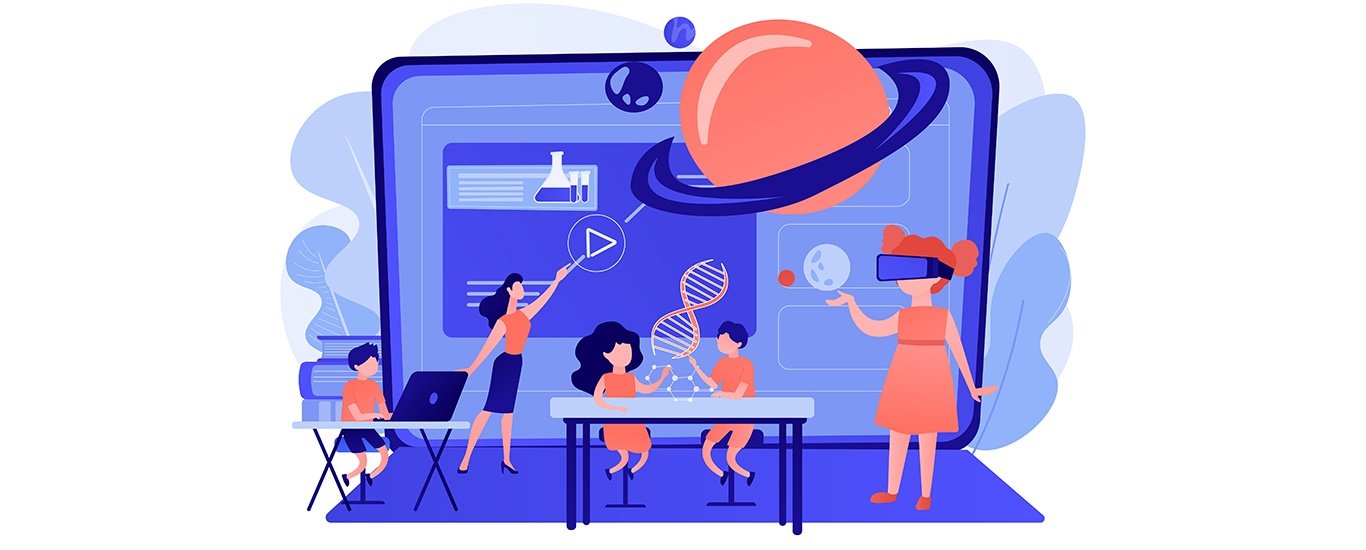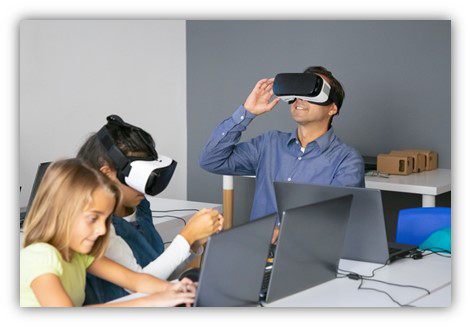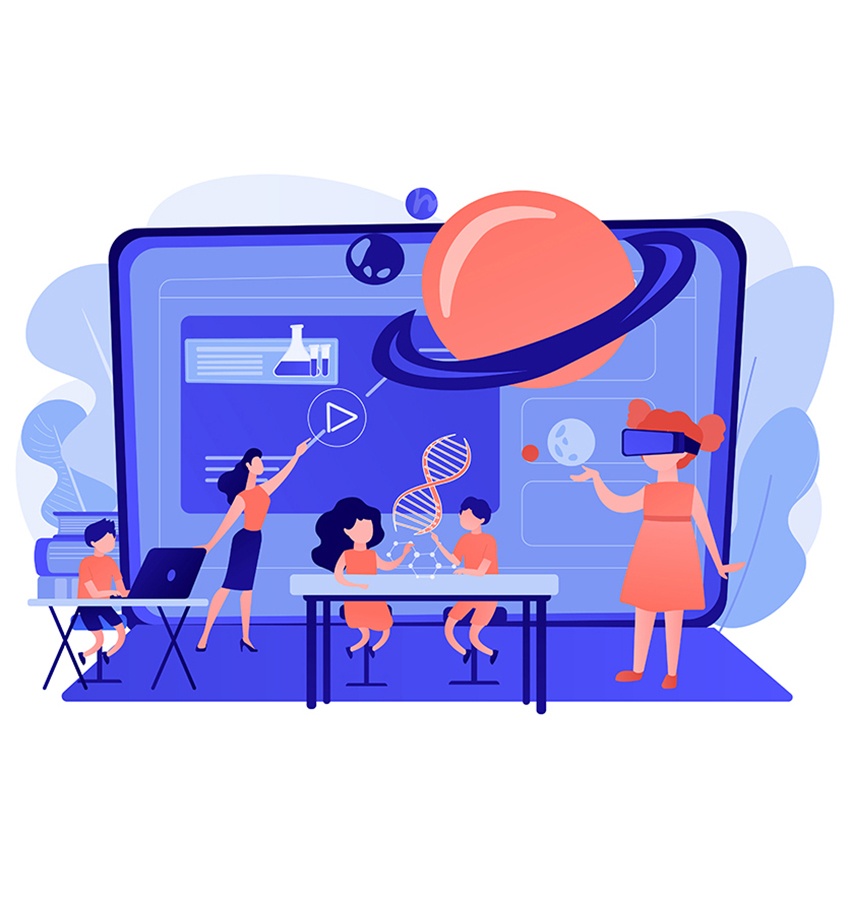
Vector representation of Virtual Reality Technology being used in teaching
Education is the foundation for the development and success of a society as well as for the nation at large. Let’s understand the role of Virtual Reality Technology in modern education. The transferring of knowledge and wisdom from one civilization to its next has always been given greater importance and is a continuous process. In the constant lookout for modern ways to approach education and transfer knowledge in a more impactful manner, technology has played a critical role. With Institutions around the world adapting to digital technology to teach and share study materials & resources with students. The modernization of education is here.
Virtual Reality technology has now stepped foot into the educational space and seems to be the way forward for institutions to make their curriculum study more immersive and insightful.
Before we delve into the how and why of Virtual Reality in education, let us first understand some of the basics of VR technology.
Virtual Reality technology provides a simulation experience of the real or modified (digitally generated) world in a virtual environment. Ultra-realistic imagery and sensations can be created through VR technology to simulate a user’s physical presence in the virtual space. Virtual Reality technology can extend to VR Headsets and Multi-projected environments for simulation purposes.
How does Virtual Reality fit into educational use?
Classroom teaching sessions can go from using the whiteboard for representation to Virtual Reality for immersive simulation. Today many schools and other institutions have incorporated virtual classrooms, which is considered to be an effective way of using VR in education. Educators can take their students on a trip around the world without having to actually leave the room. This is achieved by projecting images and videos on the walls of the classroom so as to simulate as if you were actually there at that projected location.
On the other hand, with devices becoming more compact, lighter, and portable to use, VR Headsets are more commonly used to implement VR learning in classrooms. Standalone VR Headsets provide a greater level of immersion and a highly realistic experience for students, which they aren’t likely to forget for a long time to come.
VR Technology is more suitable for educational purposes where practical learning is required, especially in fields like medical, engineering, architectural study, etc. where VR learning is highly recommended for implementation. Anything and everything you can imagine of can be generated and experienced through Virtual Reality.
Why is it essential to implement VR Technology in modern education?

A teacher and student experiencing Virtual Reality Technology
We all understand how technology plays a major part in our day-to-day lives. From mobile phones, computers, laptops to tablets and whatnot, we are connected to technology one way or the other. The implementation and use of various forms of technology have certainly made processes and activities easier to manage and perform today.
VR technology may have not necessarily been a part of our lives in comparison to other forms of digital technology, but that’s here to change. VR is increasingly being used in different types of industries, from manufacturing to retail. And now it certainly is highlighting its benefits in the educational space. Modern students are looking for modern & updated approaches for learning. Students today need faster and easier access to resources and interactive study for better understanding and retention. To understand why VR technology needs to be implemented across all branches of education, we need to look at the major benefits and advantages that VR learning has to offer –
- The first and foremost benefit is a clear perspective of a place; when students read about a particular place or destination, the information obtained is limited to text or pictorial representation. But with VR technology, students have the opportunity to immerse themselves in the virtual simulation of a given place in detail. Being able to learn in a simulated environment helps students engage their minds wholly and results in better factual retention.
- The other stand-out factor is to learn by performing; practical learning is a well-known method of study, and in comparison to traditional textbook study, learning by performing has gained higher importance. With VR technology, students can self-discover and explore on their own and enhance their knowledge acquisition process.
- It can also benefit students in developing their creative skills; with various tools and features available for use through VR devices, students can not only learn by viewing creative work but also engage in developing creative work.
- The most effective tool for visual learners, there are students who find it easier to learn and retain information through the visualized form of learning rather than just reading about facts and concepts. VR technology is highly recommended to be implemented for the use of such students to improve their learning experience.
- It provides a highly retentive educational experience; at times, what we read may have a lower recall value, but that’s not the case with VR learning. What you visualize tends to stay in the memory for a longer duration, and that’s what educators want for their students, a higher recall value.
These are some of the most highlighting benefits of the many present with VR learning, and institutions around the world are looking to incorporate these learning benefits to drastically enhance the educational experience for their students.
There is of course, some skepticism that comes with new and modern ways. Virtual Reality technology may be considered expensive for implementation, and some may also say that it could have functionality issues and be addictive for use. Despite such negative impressions, the technology is currently thriving and is being implemented by various reputed institutions around the world. Companies are working towards making these technologies much more accessible than they already are, and institutions are developing proper curriculums to match and balance the usage of VR technology in education.
The most popular area in which Virtual Reality Technology is used is in the medical field. Many reputed medical institutions have adopted VR technology in anatomical learning and patient engagement. A state-of-the-art application is the 3D Organon VR Anatomy software, which is the world’s first fully functional anatomical virtual learning application. It boasts feature-rich modules and includes detailed anatomical structures to improve the overall learning experience for medical students. Manipal digital systems are the proud distributor of 3D Organon and have catered to the VR implementation requirements across various medical institutions.
To sum it all up, Virtual Reality Technology is an essential part of the future of learning and the best fit for modern education. It creates an immersive learning experience and promises to offer a range of benefiting factors for students to improve their knowledge acquisition.
Let’s embrace Virtual Learning and move towards a brighter future.



